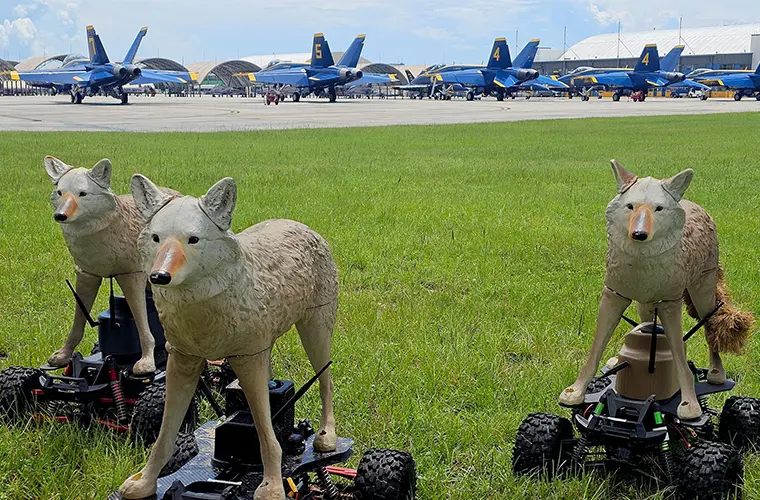The U.S. Army has launched a groundbreaking initiative to counter a persistent yet often underestimated threat bird strikes. Using a robotic bird deterrent that mimics natural predators, the military is deploying lifelike robot coyotes to keep birds away from airfields and save lives in the process.
The Hidden Danger of Bird Strikes
Bird strikes might sound harmless, but in aviation, they pose a lethal threat. Every year, they cost the U.S. military and commercial aviation over $1.2 billion in damages. Worse, they’ve caused numerous deadly crashes, including the infamous US Airways Flight 1549 “Miracle on the Hudson.”
A 2023 Department of Defense report highlighted over 5,000 bird-aircraft collisions across U.S. military bases globally. These incidents can shatter windshields, jam engines, and down aircraft.
Dr. Linda Chen, senior environmental analyst at the U.S. Army Engineer Research and Development Center (ERDC), explains, “The biggest issue is unpredictability. Birds don’t follow traffic rules. You need a flexible, natural, and persistent solution and that’s where the robotic bird deterrent shines.”
The Rise of the Robotic Coyote
These high-tech deterrents don’t just look like coyotes; they move, behave, and even smell like real predators. Using motors, AI driven movement algorithms, and scent diffusing systems, each robotic coyote creates the illusion of an actual threat to nearby bird populations.
One of the most notable deployments of the robotic bird deterrent occurred at Fort Hood. Known for its expansive flight training zones, Fort Hood has long struggled with migratory birds.
After installing just five robotic coyotes across its two main airstrips, wildlife monitoring data showed a 65% drop in bird activity within the first 30 days.
Lt. Col. James Ritter, base commander at Fort Hood, shared, “At first, our personnel laughed. But within days, birds started steering clear. We haven’t seen numbers this low in years.”
Psychology Behind the Technology
Dr. Emily Vargas, professor of avian behavior at Cornell University, supports the use of robotic bird deterrent systems, noting that fear based mimicry is highly effective, “Birds instinctively flee from coyotes. When you replicate that fear authentically through sight, motion, and smell they react the same way they would in nature.”
She adds that unlike loud noises or lasers, this method does not desensitize wildlife, making it a more sustainable option.
Personal Experience from the Field
Sergeant Matthew Lewis, a maintenance technician at a U.S. Army airbase, recalls, “We used to scrub blood and feathers off jets almost weekly. Since the robotic coyotes arrived, that’s dropped dramatically. More importantly, our pilots feel safer knowing their takeoffs are less likely to end in disaster.”
Why the Robotic Bird Deterrent Works
Eco Friendly: No chemicals, no killing just psychological deterrence.
Autonomous and Adaptable: Some models are solar powered and adjust routes using GPS and AI.
Silent Operation: No loud noise, so no disruption to nearby communities or base activity.
⚠️ Limitations:
Routine Maintenance: Moving parts and scent systems need upkeep.
Potential Adaptation: Birds may eventually recognize it’s not a real threat without occasional reinforcement (e.g., changing location or scent).
Future Implications Beyond the Military
The success of these robotic bird deterrent systems in military settings is opening doors for their use in, Commercial airports, Agricultural farms, Wind turbine farms, Solar panel fields.
Companies in the private sector have already begun investing in similar technology for non military use. With more advanced versions under development integrated with drones and thermal sensors this approach could become the global standard for bird deterrence.
An Innovative Step Toward Safer Skies
As the U.S Army embraces cutting edge solutions like the robotic bird deterrent, it’s not just responding to a threat it’s reshaping how we interact with nature using technology. These robot coyotes are more than just gadgets; they’re a bold symbol of innovation, adaptation, and life saving strategy.
In a world where a single bird can bring down a multi million dollar aircraft, the robotic coyote may be one of the Army’s most unexpected heroes.

